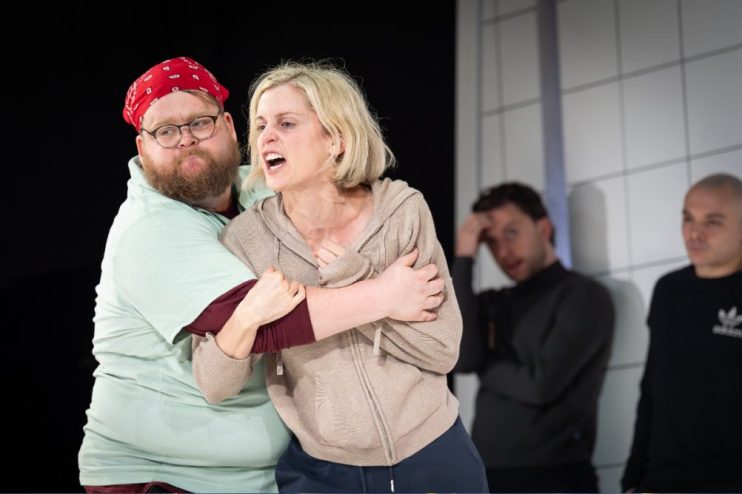People, Places and Things at Trafalgar Theatre: Rehab laid bare

People, Places and Things star rating: ★★★★
Duncan Macmillan’s play People, Places and Things is a story about addiction, but it is also a story about theatre. The main character is a liar, an alcoholic, a drug addict and – just as importantly – an actor.
Emma (a role reprised by the brilliant Denise Gough after a 2015 run at the National Theatre) checks into rehab, reluctantly, at a centre that adheres to an Alcoholics Anonymous-style, religion-based approach centred around “The Group”. “We recover as a group,” The Group says. Isolation will lead to relapse.
Although she makes the choice to recover, she is not an easy patient. “You need to tell me you want help,” pleads her psychiatrist. But Emma looks down on these Jesus-quoting simpletons. Called out for her refusal to reveal the truth about her past, she says – hilariously – “it’s not lying, it’s admitting there’s no truth – have you not read Foucault?” Intellectually inferior as I may be, her therapist responds, I’m trying to save your life. “You need to at least match me intellectually,” replies Emma.
It’s not lying, it’s admitting there’s no truth – have you not read Foucault?
Throughout the first half, she battles the psychiatric model of healthcare. She denies carrying trauma, outlines the absurdity of complaining about her life when across the world “people are starving”. “We’re not defective,” she says. “The world is fucked”. How can we live a normal life, she asks, in the knowledge that we will one day be dust? The “ethical gymnastics” we use to pretend everything is normal is exhausting. It is easier for Emma to shrug off her personality and play other parts. “You never had a personality,” she is cruelly told. Instead, she dons the parts of others with easy charm. What kind of person thrives as an actor?
Acting forms the basis of the therapy sessions, with members of the group demanding that Emma act out figures from their past in the hope they will gain forgiveness and understanding. But when she ventures into the real world, her rehearsals crumble into naive fantasies. This is a play that deftly refuses an easy recovery narrative. Some characters make it, some don’t – and there is no morality crudely ascribed.
People, Places and Things burns with pain and conflict, but it is also very funny. The scriptwriting is deft, with plot twists complicating the meaning and throwing into doubt Emma’s reliability as a protagonist. The world of rehab mirrors the world of theatre. Both are presented as self-indulgent, a little make-believe. It questions what it means to be authentic, to embrace the idea that addiction is an illness that stems from trauma. What if I don’t have trauma, asks Emma.
Bunny Christie’s set design is effective: white tiles frame a simple set, with the glaring LEDs you would expect from the psychiatric clinic of your nightmares. It is both claustrophobic and simple. The choreography is powerful and dramatic: an addict rushes on during Emma’s check-in with red paint scrawled on his torso reading THE END while medics whirl around him. At a graduation party for a patient who is leaving the centre, Emma stands exposed on stage left, still fighting her doctors’ request for truth, while her tell-all Group comrades stand on stage right dressed in viking hats, oversized sunglasses and funny wigs.
Gough is a fantastic actor, compelling to the end. She is aggressively physical, fiddling endlessly, her drunken torso swaying in all directions; withdrawal curls her toenails. Her portrayal of Emma is loud and abrasive but also clever, always leaving something hidden.
Knowing yourself is impossible, finding coping mechanisms and solidarity in a group, however imperfect, makes things a little easier.
It’s hard to portray addiction on stage and this show deserves credit for conveying the complexities of the illness. The clinicians are clear from the onset: detoxing is the “easy part”. ‘Easy’ turns out to be palpitating techno pounding in your ears, parallel personalities sliding out from under your bed, and strange figures slinking menacingly across the stage. These adrenaline-fuelled nightmare scenes see doctors’ voices fading in and out as the audience is dragged through the psychotic pain of withdrawal.
Not all threads are neatly tied up: while the show purports to be about AA, the religious element and ongoing participation are never fully addressed. We also never really understand Emma’s story, and while this can be frustrating, it is also fitting. Knowing yourself is impossible, finding coping mechanisms and solidarity in a group, however imperfect, makes things a little easier.
People, Places and Things ends in a climax that mirrors the first scene, compounding a damning analysis of the perils of an acting career combined with wobbly mental health. It’s a career that will pull you in, spit you out, and leave you for damned. For her part, Gough shows how powerful it can be.